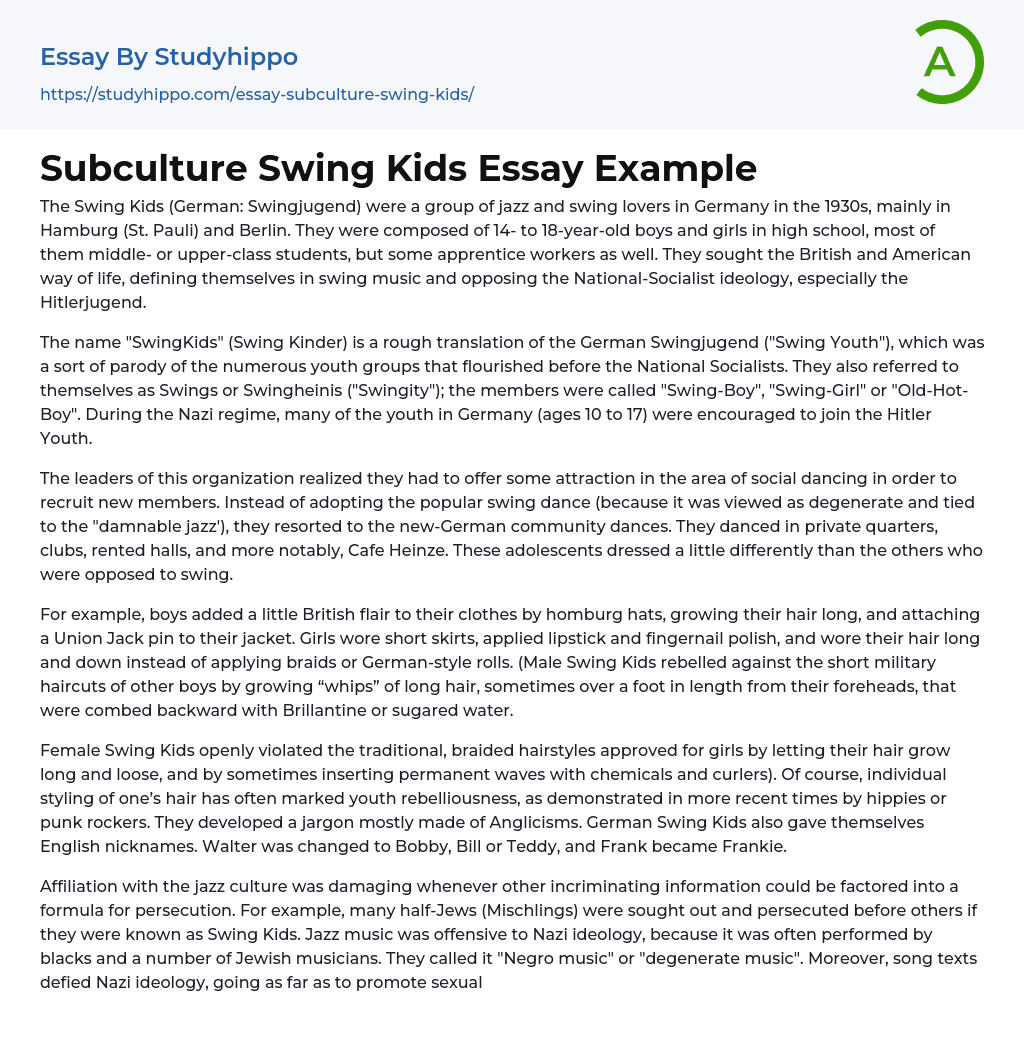The Swing Kids (German: Swingjugend) were a group of jazz and swing lovers in Germany in the 1930s, mainly in Hamburg (St. Pauli) and Berlin. They were composed of 14- to 18-year-old boys and girls in high school, most of them middle- or upper-class students, but some apprentice workers as well. They sought the British and American way of life, defining themselves in swing music and opposing the National-Socialist ideology, especially the Hitlerjugend.
The name "SwingKids" (Swing Kinder) is a rough translation of the German Swingjugend ("Swing Youth"), which was a sort of parody of the numerous youth groups that flourished before the National Socialists. They also referred to themselves as Swings or Swingheinis ("Swingity"); the members were called "Swing-Boy", "Swing-Girl" or "Old-Hot-Boy". During the Nazi regime, many of the youth in Germany (ages 10 to 17)
...were encouraged to join the Hitler Youth.
The leaders of this organization realized they had to offer some attraction in the area of social dancing in order to recruit new members. Instead of adopting the popular swing dance (because it was viewed as degenerate and tied to the "damnable jazz'), they resorted to the new-German community dances. They danced in private quarters, clubs, rented halls, and more notably, Cafe Heinze. These adolescents dressed a little differently than the others who were opposed to swing.
For example, boys added a little British flair to their clothes by homburg hats, growing their hair long, and attaching a Union Jack pin to their jacket. Girls wore short skirts, applied lipstick and fingernail polish, and wore their hair long and down instead of applying braids or German-style rolls. (Male Swing Kids rebelled against the short
military haircuts of other boys by growing “whips” of long hair, sometimes over a foot in length from their foreheads, that were combed backward with Brillantine or sugared water.
Female Swing Kids openly violated the traditional, braided hairstyles approved for girls by letting their hair grow long and loose, and by sometimes inserting permanent waves with chemicals and curlers). Of course, individual styling of one’s hair has often marked youth rebelliousness, as demonstrated in more recent times by hippies or punk rockers. They developed a jargon mostly made of Anglicisms. German Swing Kids also gave themselves English nicknames. Walter was changed to Bobby, Bill or Teddy, and Frank became Frankie.
Affiliation with the jazz culture was damaging whenever other incriminating information could be factored into a formula for persecution. For example, many half-Jews (Mischlings) were sought out and persecuted before others if they were known as Swing Kids. Jazz music was offensive to Nazi ideology, because it was often performed by blacks and a number of Jewish musicians. They called it "Negro music" or "degenerate music". Moreover, song texts defied Nazi ideology, going as far as to promote sexual permissiveness or free love.
Despite this, not all jazz was forbidden in Germany at the time. A popular term that the swing subculture used to define itself was Lottern, roughly translated as something between "laziness" and "sleaziness", indicating contempt for the pressure to do "useful work" and the repressive sexual mores of the time. On 18 August 1941, in a brutal police operation, over 300 Swingjugend were arrested. The measures against them ranged from cutting their hair and sending them back to school under close monitoring, to the deportation
of the leaders to concentration camps.
- Clothing essays
- Footwear essays
- Fashion design essays
- Cosmetic Surgery essays
- Jeans essays
- Travel essays
- Asia essays
- Caribbean essays
- Developing Country essays
- America essays
- City essays
- Africa essays
- Australia essays
- Europe essays
- Georgia essays
- Middle East essays
- New Zealand essays
- South Korea essays
- Thailand essays
- Afghanistan essays
- Dubai essays
- North Korea essays
- Natural Disaster essays
- Earthquake essays
- Fracking essays
- Mountains essays
- Restaurant essays
- Hospitality essays
- Business Travel essays
- Hotels essays
- Tourism essays
- World Tourism Organization essays
- Kids travel essays
- Travel Agency essays
- ecotourism essays
- Air Travel essays
- Sea Travel essays
- Cathedral essays
- Traveling essays
- Fast Food Restaurant essays
- Motel essays
- Cultural Tourism essays
- The real essays
- Airlines essays
- Airports essays
- Boeing essays
- Low-Cost Carrier essays
- Easyjet essays
- Bangladesh essays
- Kuala Lumpur essays




